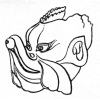Karura of Kofukuji.jpg on:
[Wikipedia]
[Google]
[Amazon]
 The is a divine creature with human torso and birdlike head in Japanese mythology.
The name is a
The is a divine creature with human torso and birdlike head in Japanese mythology.
The name is a
 The karura (garuda) mask is one of the stock character masks worn by performers of the ancient Japanese courtly dance art of gigaku.
The flaming nimbus or halo is known by the name "karura flame" and typically seen adorning behind the statue of the ).
The karura is also said to be the prototype of the depictions of the ''tengu'' or ''karasutengu''.
The karura (garuda) mask is one of the stock character masks worn by performers of the ancient Japanese courtly dance art of gigaku.
The flaming nimbus or halo is known by the name "karura flame" and typically seen adorning behind the statue of the ).
The karura is also said to be the prototype of the depictions of the ''tengu'' or ''karasutengu''.
 The is a divine creature with human torso and birdlike head in Japanese mythology.
The name is a
The is a divine creature with human torso and birdlike head in Japanese mythology.
The name is a transliteration
Transliteration is a type of conversion of a text from one script to another that involves swapping letters (thus ''trans-'' + '' liter-'') in predictable ways, such as Greek → , Cyrillic → , Greek → the digraph , Armenian → or L ...
of garuda
Garuda (Sanskrit: ; Pāli: ; Vedic Sanskrit: गरुळ Garuḷa) is a Hindu demigod and divine creature mentioned in the Hindu, Buddhist and Jain faiths. He is primarily depicted as the mount (''vahana'') of the Hindu god Vishnu. Garuda ...
, a race of enormously gigantic birds in Hinduism
Hinduism () is an Indian religion or '' dharma'', a religious and universal order or way of life by which followers abide. As a religion, it is the world's third-largest, with over 1.2–1.35 billion followers, or 15–16% of the global p ...
. the Japanese Buddhist version is based upon Hindu Mythology. The same creature may go by the name of .
The karura is said to be enormous,. Japanese dictionary, 2nd revised edition fire-breathing, and to feed on dragons/serpents, just as Garuda is the bane of Nāga
The Nagas (IAST: ''nāga''; Devanāgarī: नाग) are a divine, or semi-divine, race of half-human, half-serpent beings that reside in the netherworld (Patala), and can occasionally take human or part-human form, or are so depicted in art. ...
s. Only a dragon who possesses a Buddhist
Buddhism ( , ), also known as Buddha Dharma and Dharmavinaya (), is an Indian religion or philosophical tradition based on teachings attributed to the Buddha. It originated in northern India as a -movement in the 5th century BCE, and ...
talisman, or one who has converted to the Buddhist teaching, can escape unharmed from the Karura. Shumisen or Mount Meru
Mount Meru (Sanskrit/Pali: मेरु), also known as Sumeru, Sineru or Mahāmeru, is the sacred five-peaked mountain of Hindu, Jain, and Buddhist cosmology and is considered to be the centre of all the physical, metaphysical and spiritu ...
is said to be its habitat.
Karura is one of the proselytism, proselytized and converted creatures recruited to form a guardian unit called the .The multilexic dictionary does not give an English or any other language equivalent for this entry.
One famous example is the Karura statue at Kōfuku-ji, Nara, Nara, Nara, amongst the eight deva statues presented at the Buddhābhiṣeka dated to the year Tenpyō 6 or 734, pictured top right). This karura is depicted as wearing Tang dynasty, Tang Chinese-style armor, and thus is seen wingless.
But more conventionally, the Karura is depicted as a winged being with human torso and avian head, as in the Vajra Hall () section of the Womb Realm mandala () and other iconographic books and scrolls.
In fine art
 The karura (garuda) mask is one of the stock character masks worn by performers of the ancient Japanese courtly dance art of gigaku.
The flaming nimbus or halo is known by the name "karura flame" and typically seen adorning behind the statue of the ).
The karura is also said to be the prototype of the depictions of the ''tengu'' or ''karasutengu''.
The karura (garuda) mask is one of the stock character masks worn by performers of the ancient Japanese courtly dance art of gigaku.
The flaming nimbus or halo is known by the name "karura flame" and typically seen adorning behind the statue of the ).
The karura is also said to be the prototype of the depictions of the ''tengu'' or ''karasutengu''.
In popular culture
The ''Pokémon'' evolutionary line of Magby, List of generation I Pokémon#Magmar, Magmar, and Magmortar are based on the karura.See also
::::::* Avalerion ::::::* Garuda ::::::* Kalaviṅka ::::::* Kinnara ::::::* List of avian humanoids ::::::* List of Zatch Bell! characters ::::::* Tengu ::::::* UtawarerumonoReferences
External links
* Buddhist gods Birds in Buddhism Japanese legendary creatures Mythological birds of prey Avian humanoids {{Japan-myth-stub